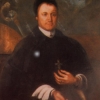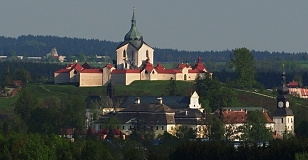Václav Vejmluva (September 19, 1670 – March 17, 1738)
 Václav Vejmluva was born on 19 September 1670 in the family of Jan Vejmluva, a maltster in the brewery of the Cistercian nunnery in Staré Brno. When he was eighteen, he entered the novitiate in the monastery in Žďár on 1 January 1689. In the same year, he had to leave the monastery temporarily together with other monks because of a disaster which hit the convent on 19 October. The monastery burned to the ground on that day, it was not possible to live in the heavily damaged convent buildings and the condition of the church did not allow to say masses. Thus the monks had to take shelter in other Cistercian monasteries for some time, at least until the the buildings were partially repaired.
Václav Vejmluva was born on 19 September 1670 in the family of Jan Vejmluva, a maltster in the brewery of the Cistercian nunnery in Staré Brno. When he was eighteen, he entered the novitiate in the monastery in Žďár on 1 January 1689. In the same year, he had to leave the monastery temporarily together with other monks because of a disaster which hit the convent on 19 October. The monastery burned to the ground on that day, it was not possible to live in the heavily damaged convent buildings and the condition of the church did not allow to say masses. Thus the monks had to take shelter in other Cistercian monasteries for some time, at least until the the buildings were partially repaired.
Novice Václav Vejmluva used to stay in Plasy, a monastery in west Bohemia. There, in the presence of local abbot Ondřej Trojer, he took the famous vow of poverty, chastity and obedience on 28 March 1690. Then he studied at the Archbishop´s Seminary of the Bernardinum College in Prague and became a priest on 16 January 1695. In the meantime, Edmund Wagner became the abbot in the mother monastery in 1691; his task was to continue and to complete the repairs which started immediately after the fire. The monastery was slowly rising from the ruins under the leadership of the very eligible man. Václav returned to the monastery in Žďár after completion of studies, and started to work there as an economist; he controlled the management of the monastery and later also the secretary of the abbot. The promotion suggests that Vejmluva certainly was a competent man, which in particular was confirmed later when he held the office of the abbot.
Abbot Wagner paid the debt of nature in March 1705; while holding the office in Žďár, he not only managed to repair the monastery after the tragic fire but also to release it from all debts. The election of the new abbot took place in the monastery at the end of May. This important step required not only the presence of the monastery occupants but also of Benedikt Littwerig – the abbot of the monastery in Osek, Jindřich Snopek – an abbot in Sedlec, the representatives of the Moravian Provincial Assembly (moravský zemský sněm), Karel Antonín, Count Braida and Cyril Josef – a baron of Košín, all of them acting as supervisors. Václav Vejmluva was successful in the election; by the way, deceased abbot Wagner recommended him as his successor. The election was then confirmed by the Emperor. Thus nothing prevented less than 35-year old Václav Vejmluva from taking a vow and becoming an abbot (24 June). He was ceremonially ordained a priest by a suffragan from Olomouc on 15 September. The following years of Vejmluva´s life were dedicated to the unceasing care of the economic and spiritual development of the monastery. He did not forget to take care of the peasants living in the monastery manor.
The fact that Vejmluva met with young architect Jan Blažej Santini-Aichel some time in 1706 was of a quite extraordinary importance. These two men understood each other in the area of architecture and fine arts, which produced a lot of fruits in the form of buildings within the monastery manor; some of the buildings have been preserved up to now.
It seems that the first Santini´s task in Žďár was to fit the interior of the monastery church and to fit the convent. As for the monastery church, the adjustment concerned the enrichment of the relatively austere interior. Santini performed the task with unusual sensitivity, yet with courage. New stucco shapes thus occurred in the church in 1708 and a bridge organ gallery was added above the place where the transept crosses the nave at the crossing. Santini as an author is traceable in the adjustments of the convent, well chapel, south wing of the quadrature and snail stairs in the west wing.
So called Lower Cemetery was established to the north west of the monastery in 1709. An old people´s house and an inn were then built in the foreground of the church as designed by Santini. A farm called "Lyra" was built near the monastery in 1720. Before Santini died in 1722, he probably projected an academy for Vejmluva where noble young men could be educated.
The pilgrimage Church of St. John of Nepomuk at Zelená hora is rightly considered the most remarkable building designed by Santini in the service of Václav Vejmluva. Santini maybe applied all his skills to design the project and the church still receives the best possible reviews. However, abbot Vejmluva could only enjoy the finished building himself – without Santini who died in December 1723.
It is documented that there were more than 50 brothers in Žďár while Vejmluva was the abbot, which is the most in the whole history of the monastery. The 500 year anniversary since the foundation of the monastery (i.e. since the introduction of the monks to Nížkov) could thus be celebrated with real pomp between 28 August – 4 September 1735, and Vejmluva and his brothers had prepared for it diligently. However, dark clouds started to gather in the distance...
The treasury of the monastery was considerably exhausted by challenging building activities and the monastery experienced another disaster in less than two years after the celebration. The monastery was willfully set on fire on 9 May and the fire burnt a large part of the library and the rich equipment and decoration of the convent. The interior of the church was only saved from the fire thanks to the immense effort of the monks. The fire had a much more tragic impact on sixty-seven-year-old abbot Vejmluva. The old man did not manage to cope with the horrible incident. Maybe also because of the fact that had seen the monastery burned with destructive fire in 1689 when he was a novice; he therefore knew very well what effort they would have to make to renew the monastery and that a lot of the valuables destroyed by the fire could not be replaced with anything. He had a stroke on the third day after the fire. He remained alive and his condition even improved but death finally rescued him from the far from easy lot which he had born with great patience, devotion and love, in less than a year after the incident, on 17 March 1738. The word “rescue“ has been used quite intentionally, with awareness that the monastery manor found itself in the middle of war for Austrian heritage in the following years. Plundering armies did not save anybody or anything and, at best, put up with high ransom for at least some time...


 Back to top
Back to top Search
Search